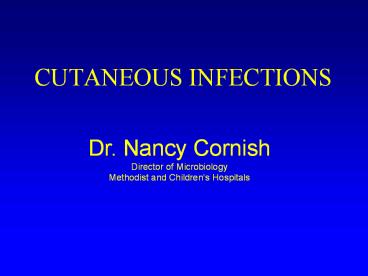CUTANEOUS INFECTIONS PowerPoint PPT Presentation
Title: CUTANEOUS INFECTIONS
1
CUTANEOUS INFECTIONS
Dr. Nancy Cornish Director of Microbiology Method
ist and Childrens Hospitals
2
Dermatophytoses (Ringworm, tinea)
- Pruritic, scaly, erythematous lesions with
central clearing - Common agents of infection
- Epidermophyton floccosum
- Trichophyton species
- Microsporum species
- Topical or oral antifungal medications
3
(No Transcript)
4
(No Transcript)
5
(No Transcript)
6
(No Transcript)
7
(No Transcript)
8
(No Transcript)
9
Lab Diagnosis
- Cutaneous Fungal Infection
- Lesion cleaned with 70 alcohol
- Skin scrapings from active margin
- Scalpel or toothbrush
- KOH prep, examine microscopically
- Rapid, inexpensive
- Culture, if KOH negative
- Hold 4 weeks
- Can speciate, if necessary
10
Colorless (hyaline) branched septate hyphae
arthroconidia
11
Calcofluor Stain
12
LAB Diagnosis
- Nails
- Clean with 70 alcohol or soap and water
- Clip nail back as far as possible and discard
nail clippings - Obtain crumbling subungual debris from beneath
trimmed nail edge with curette - KOH prep, examine microscopically
- Culture, if KOH negative
13
LAB Diagnosis
- Hair
- With forceps, collect 10 to 12 affected hairs
with base of shaft intact, also collect scalp
scales if present at active borders of lesions - Use of Woods lamp (UV light) can assist in
selecting hair for culture as affected hair will
usually fluoresce bright yellow-green - Submit for culture
14
Candidiasis
- Infects skin or mucous membranes (mouth, vagina)
- Colonizer of normal hosts
- Skin - raw, moist, red with small satellite
papules or pustules - Mucous membranes - white moist patches with
erythematous margin
15
Candidiasis
- Predisposing Conditions
- Immunosuppression
- HIV
- Chemotherapy
- Steroids
- Diabetes mellitus
- Cutaneous maceration
- Groin, infra mammary folds
- Diaper area
- Antibiotic treatment
- Vagina - vaginitis
- Mouth - thrush
16
Cutanous candidiasis
17
Thrush - Candida
18
Diaper rash - Candidiasis
19
Candidiasis
- LAB DX
- Usually clinical diagnosis
- If culture, then Candida screen
- Selective fungal agar
- Hold 5 - 7 days
- Treatment
- Oral antifungal agents
- Topical antifungal ointments
20
Hyaline Branching Septate pseudohyphae with
blastocondia and budding yeast
21
Tinea Versicolor (pityriasis)
- Due to lipophilic yeast Malassezia furfur
- Faintly erythematous or hypopigmented macules
with fine scale - Involves torso, upper limbs
- Woods UV lamp will cause infected area to
fluoresce yellow-green - If culture, requires lipid for growth (olive oil
overlay).
22
Tinea versicolor
23
Tinea versicolor
24
Tinea versicolor rubbing lesion produces fine
scale.
25
T. versicolor - buds through phialidic collerettes
26
T. versicolor Spaghetti and meatballs
27
Erythrasma
- Chronic superficial bacterial skin infection of
the stratum corneum - Cause Corynebacterium minutissimum
- Fine, scaly, reddish-brown macules or plaques
- Prefers toe webs, genitocrural areas
- Tx Erythromycin
28
(No Transcript)
29
(No Transcript)
30
LAB Diagnosis Erythrasma
- Woods lamp coral red fluorescence due to
porphyrin production - Gram stain of skin surface scale shows many small
pleomorphic gram positive bacilli, coccobacilli
or filaments - Culture rarely needed
31
(No Transcript)
32
Ulcers and Nodules and Sporotrichoid lesions
33
Ulcers
- Loss of epidermal and dermal layers
34
(No Transcript)
35
Nodules
- Inflammatory foci in which the most superficial
cutaneous layers are intact
36
Sporotrichoid lesions
- Ulceronodular infection with lymphatic
involvement - ?can travel up lymphatic vessels and create
satellite lesions
37
Ulcers and Nodules
- Variety of bacteria and fungi cause these lesions
- Two mechanisms
- Direct inoculation
- Hematogenous dissemination
38
Organisms that cause ulcers or nodules or both
after direct inoculation
- EXAMPLES
- Corynebacterium diphtheriae
- Bacillus anthracis
- Francisella tularensis
- Nocardia species
- Mycobacterium marinum
- Sporothrix schenckii
39
Cutaneous diphtheria
40
F. tularensis tularemia
41
M. marinum swimming pool granuloma
42
Sporotrichosis
43
Malignant pustule of anthrax
44
Late stage anthrax
45
B. anthracis non-hemolytic non-motile
46
Organisms that cause ulcers or nodules after
hematogenous dissemination
- EXAMPLES
- Aspergillus species
- Blastomyces dermatitidis
- Cryptococcus neoformans
- Mycobacterium tuberculosis
47
Sporotrichoid lesions
- These lesions begin as an ulcerated nodular
lesion at the site of inoculation, primarily on
the extremities, followed by development of
subcutaneous nodules with overlying erythema and
occasional ulceration proximally along lymphatics.
48
Sporotrichoid lesions
- EXAMPLES
- Sporothrix schenckii
- Mycobacterium marinum
- Norcardia spp.
49
Sporothrix schenckii
- Classic example of Sporotrichoid lesion
- Dimorphic soil fungus, rose bushes
- Yeast phase at 37C
- Fungal hyphae phase at 25C
- Gardeners, farmers, florists at risk

